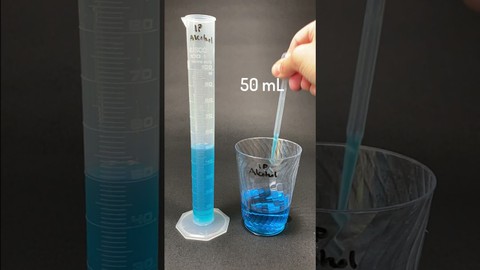Have you ever wondered what happens when you mix two liquids together? It seems like a simple question with a straightforward answer: combine 50 milliliters of one liquid with 50 milliliters of another, and you should end up with 100 milliliters of mixture, right? Well, not always! In the curious world of chemistry, combining 50mL of alcohol with 50mL of water doesn’t make 100mL, and the reason behind this is as fascinating as it is fundamental to understanding the nature of matter itself.

The Scientific Principle of Volume Change when Alcohol and Water are Mixed
Let’s dive into the science of why mixing alcohol and water results in a volume that’s less than the sum of its parts. This phenomenon is rooted in the concept of ‘partial molar volume.’ When two solutions of different substances are mixed, the volume of the resulting solution is not always additive. This is because the molecules of the two substances interact in a way that allows them to pack more closely together than they would if they were simply surrounded by their own kind.
Water and ethanol, the type of alcohol typically used in beverages, are both polar solvents. This means that their molecules have a slight electrical charge that causes them to be attracted to each other. When water is added to ethanol, the smaller water molecules are drawn to the ethanol’s hydroxyl group. This attraction changes the way the molecules are arranged in space, allowing them to fit more closely together than they would in separate solutions. As a result, when you mix equal volumes of water and ethanol, the total volume decreases slightly.
This decrease in volume upon mixing is not unique to water and alcohol; it’s a common occurrence when mixing various types of liquids. However, the extent of the volume change depends on the specific substances involved and their concentrations. For mixtures of water and ethanol, the maximum volume contraction is less than 2.5%, and for concentrations under 20%, the difference is less than 0.5%. While these numbers might seem small, they are significant in fields where precise measurements are crucial, such as pharmacology and chemistry.
The concept of alcohol by volume (ABV) is a standard measure used worldwide to indicate how much alcohol is contained in a given volume of an alcoholic beverage. It is defined as the number of milliliters of pure ethanol present in 100 mL of solution at 20 °C. The ABV standard is crucial for understanding the strength of a beverage and is used for legal, commercial, and health-related purposes. The International Organization of Legal Metrology provides tables of density for water-ethanol mixtures at different concentrations and temperatures to aid in these determinations.
In some countries, like France, alcohol by volume is referred to as degrees Gay-Lussac, named after the French chemist Joseph Louis Gay-Lussac. Although similar, the Gay-Lussac system uses a different standard temperature value, which can lead to slight variations in measurements. Regardless of the system used, understanding the relationship between alcohol content and volume is essential for both producers and consumers of alcoholic beverages.
The intermolecular forces at play in the mixing of alcohol and water are also responsible for other interesting phenomena in chemistry. For example, the heat of fusion and heat of vaporization of water are both affected by these forces. The heat of vaporization, which is the energy required to convert water from a liquid to a gas, is greater than the heat of fusion, the energy required to melt ice. This is due to the strong hydrogen bonds that must be overcome to vaporize water.
The chemical identity of a substance does not change during a physical change, such as when water freezes or evaporates. This is different from a chemical change, like the rusting of iron, which involves a change in chemical composition. Understanding these differences is key to grasping the fundamental principles of chemistry.
The study of chemistry is not just about observing changes; it’s about understanding the interactions at the molecular level that lead to these changes. When we mix alcohol and water, we witness a simple yet profound demonstration of how the microscopic world influences the macroscopic one. It’s a reminder that even the most basic actions, like pouring a drink, are governed by the complex and beautiful laws of nature.
In the next section, we will explore the practical implications and applications of the volume changes observed when alcohol and water are mixed. From the production of alcoholic beverages to the legal thresholds for alcohol content, the understanding of these volume anomalies plays a significant role in various industries and scientific fields.
The Practical Applications and Implications of Volume Change when Alcohol and Water are Mixed
The interplay between alcohol and water is not just a curiosity of the laboratory; it has real-world implications that touch on various aspects of life and industry. In this section, we delve into the practical ramifications and applications of the alcohol-water volume anomalies, exploring how this seemingly esoteric chemical principle has far-reaching consequences.
Let’s consider the production of alcoholic beverages. The art of crafting drinks such as beer, wine, and spirits relies heavily on the precise measurement of alcohol content. This is where the concept of alcohol by volume (ABV) becomes critical. As we’ve learned, ABV is a standard measure indicating the amount of alcohol contained in a given volume of an alcoholic beverage. It’s a crucial metric for producers who must ensure their products meet the legal and quality standards for their category. For instance, a wine labeled as having 14% ABV must accurately reflect that percentage to avoid misleading consumers and to comply with regulations.
The phenomenon of volume contraction when mixing alcohol with water also has implications for the legal thresholds of alcoholic content. In some countries, beverages with an ABV below a certain level may be classified as non-alcoholic. For example, in Finland, products under 3 degrees can be sold as alcohol-free. This classification is essential for consumers who wish to avoid alcohol for health, religious, or personal reasons. It also affects taxation and distribution laws, as alcoholic and non-alcoholic beverages are often subject to different regulations.
Moving on to biological thresholds, the understanding of ABV is crucial in gauging the potential effects of alcohol consumption on the body. Low-alcohol drinks, typically with an ABV of less than 0.5%, are unlikely to cause intoxication due to the body’s ability to metabolize alcohol at a rate that outpaces the intake from such beverages. This knowledge is beneficial for individuals who wish to enjoy the social aspects of drinking without the associated impairment.
In the realm of fermentation science, the alcohol-water volume anomaly sets a natural limit to the alcohol content that can be achieved through fermentation alone. Yeasts, the microorganisms responsible for converting sugars into alcohol, have a tolerance threshold. Beyond a certain alcohol concentration, typically around 14-18% for wine yeasts, the environment becomes too toxic for the yeast to survive. This threshold defines the upper limit of ABV for non-distilled alcoholic drinks, such as beer and wine. To achieve higher alcohol concentrations, distillation is required, which separates alcohol from water based on their differing boiling points.
The practical estimation of alcohol content during the production of wine and beer is another area where the understanding of volume changes is vital. Brewers and winemakers use tools like hydrometers to measure the specific gravity of a solution before and after fermentation, allowing them to estimate the ABV of their product. This process is crucial for quality control and to ensure that the beverage meets the expected standards for its type.
In addition to these applications, the alcohol-water volume anomaly has implications for the legal and commercial aspects of the beverage industry. Alcohol content determines how a drink is categorized, taxed, and sold. It also affects import and export regulations, as different countries have varying standards for what constitutes an alcoholic beverage.
The understanding of ABV and volume changes is essential for health professionals and policymakers. It informs guidelines on safe drinking levels and helps shape public health campaigns aimed at reducing alcohol-related harm. Knowing the actual alcohol content of beverages enables individuals to make informed decisions about their consumption.
The curious case of alcohol and water not combining to a predictable volume is more than just a scientific oddity. It has tangible implications for the production, classification, and consumption of alcoholic beverages. It affects legal standards, health guidelines, and the very nature of the drinks we enjoy. As we’ve seen, the world of chemistry is not confined to the laboratory; it extends into our daily lives, shaping the industries we rely on and the choices we make. The next time you pour yourself a glass of your favorite drink, take a moment to appreciate the complex science that makes it possible.
Related posts:
Alcohol by volume
CH104: Chapter 7
The 15 Least Fattening Ways to Get Drunk





